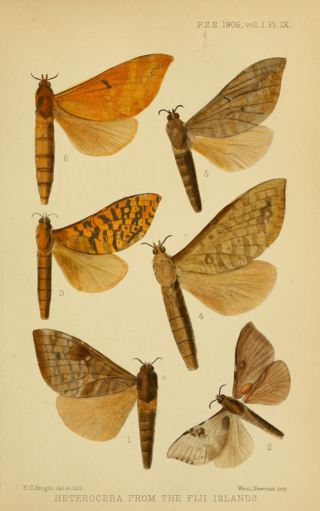
The Hepialidae are a family of insects in the lepidopteran order. Moths of this family are often referred to as swift moths or ghost moths.

Phassodes is a moth genus of the family Hepialidae. As of 2018, it is monospecific, consisting of the sole species Phassodes vitiensis; this species is very variable. It is found in Fiji and Samoa. The life cycle is unknown but the larva is presumed to feed underground on the roots of plants or decaying matter.

Aoraia enysii, also known as the forest ghost moth is a species of moth of the family Hepialidae. It is endemic to New Zealand. This is the only species of the genus Aoraia that can be found in the North as well as the South Island. This species can be found from Mount Te Aroha southwards. This species was described by Arthur Gardiner Butler in 1877 from a specimen obtained in the North Island by J. D. Enys.
Callipielus fumosa is a species of moth of the family Hepialidae. It is known from Chile.
Cibyra brasiliensis is a species of moth of the family Hepialidae. It is known from Brazil, from which its species epithet is derived.
Cibyra gugelmanni is a species of moth of the family Hepialidae. It is known from Mexico.
Cibyra mexicanensis is a species of moth of the family Hepialidae. It is known from Mexico, from which its species epithet is derived.
Cibyra munona is a species of moth of the family Hepialidae. It is known from Brazil.
Cibyra oreas is a species of moth of the family Hepialidae. It is known to reside in Brazil.
Cibyra paropus is a species of moth of the family Hepialidae. It is known from Ecuador.
Cibyra rileyi is a species of moth of the family Hepialidae. It is native to Brazil.
Cibyra saguanmachica is a species of moth of the family Hepialidae. It is known from Colombia.
Cibyra sladeni is a species of moth of the family Hepialidae. It is known from Brazil.
Cibyra spitzi is a species of moth of the family Hepialidae. It is known from Brazil.
Cibyra verresi is a species of moth of the family Hepialidae. It is known from Brazil.
Gazoryctra macilentus commonly known as the Nothern ghost moth, is a moth species in the family Hepialidae. It is known from Siberia, the Russian Far East, Japan, Kazakhstan and Mongolia.

Sthenopis pretiosus, the gold-spotted ghost moth, is a species of moth of the family Hepialidae. It was first described by Gottlieb August Wilhelm Herrich-Schäffer in 1856. It can be found in found Brazil, Venezuela and in the eastern United States and south-eastern Canada.
Ahamus anomopterus is a species of moth of the family Hepialidae. It was described by D.R. Yang in 1994, and is known from Yunnan, China.
Ahamus menyuanicus is a species of moth of the family Hepialidae. It was described by Hong-Fu Chu and Lin-Yao Wang in 1985 and is known from Qinghai, China.
Ahamus zhayuensis is a species of moth of the family Hepialidae. It was described by Hong-Fu Chu and Lin-Yao Wang in 1985 and is known from the Tibet Autonomous Region in China.



